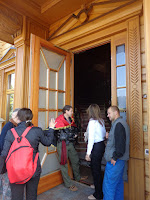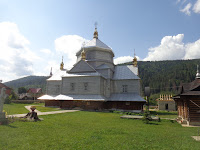Ever since I was young, I wanted to do the Great Ohio Bicycle Adventure, or GOBA for short. After my mom got even more into long-distance cycling, I had always hoped that we would be able to do it together some day. But I let life get in the way. When GOBA came through Mansfield in 2014, I made a pact with myself that I would complete the ride with her beside me in spirit. So when I found out I would be doing home leave alone with very few obligations, and it would coincide with the 2017 ride, I took it as some sort of sign -- and signed up, even though I had limited experience with multi-day, long-distance cycling.
I squeezed in as much training as I could before my bike was packed out from London, but still, I set my expectations low: I just wanted to be able to make it through the five days of mandatory riding, 40-60 miles each; I wouldn't beat myself up if I didn't feel up to doing the optional loops on rest days. After all, I wouldn't have anyone pushing me through, as I registered not knowing a single soul who would be participating. My only friend at the beginning of the week was a horse in the barn adjacent to my tent in Findlay (left). Throughout the week, I pretty much rode by myself, but nonetheless, by the last day of the event, I had made some great non-equine friends (right).
I had anticipated a lot of the ride's aspects, particularly in terms of sore body parts, but I wasn't prepared for the sheer amount of food I would be eating. The morning of the first ride, I filled up on Chris's Cakes (left). I quickly realized I don't like riding on a full stomach, so for the rest of the week, I popped a granola bar for breakfast, saving my major fueling for the rest stops. During the first optional loop (yup, I ended up riding every day, for a total of around 350 miles), I discovered exactly how delicious a popsicle can be (right).
The rest stops are remarkable for the refreshments -- I think I ate four shredded chicken sandwiches over the course of three days -- but they are also hallmarks of the camaraderie of the ride. Plopping down on a playground picnic table with your hard-boiled egg, you're soon engaged in conversation with an interesting person (left). But if you need a break to get back in gear for the final stretch, you can sip your electrolyte drink as you admire your surroundings (right).
If you get going early enough, it's pretty easy to finish the day's ride with plenty of time to spare to visit some tourist sights. I never got up before 6:30 a.m., but I never made it to the day's destination later than 1:30 p.m. Lots of attractions, such as the American Civil War Museum of Ohio in Tiffin, accommodated riders by opening on off hours (top left). And of course, there are plenty of sights along each day's route; we crisscrossed the rain-flush Sandusky River quite a few times (top right). The Pottersburg covered bridge provided passage not over the river, but over Big Darby Creek (bottom left). Photo ops were a great way to take a break after climbing hills. I decided to take this shot of Mount Tabor after, earlier in the day, I unknowingly sped right past Campbell Hill, the highest point in Ohio, just outside Bellefontaine (bottom right).
My first order of business once I got to town -- after showering, anyhow -- was to set up my tent. Before I got too tired or distracted, I wanted to make sure I had a place to crash. Most days, camping was first-come, first-serve on grassy spots at county fairgrounds. Some locations were more campground-like, such as Hedges-Boyer Park in Tiffin, where I read like two pages before passing out (top left). Often, you were close to your neighbor, but I didn't really mind the cramped quarters, especially during a rainbow in Tiffin (top right) or a sunset in Upper Sandusky (middle). I especially preferred them to sleeping indoors, which we did the last two nights, at Bellefontaine High School (bottom left) and at the Hardin County Fairgrounds (bottom right), because of forecast then actual heavy rains.
Most cities provided evening entertainment for riders. As the first (and final) stop, Findlay hosted a participant parade through downtown (top left) that led to an opening ceremony, where awards were handed out for the best costumes related to the ride's Wizard of Oz theme (top right). In Tiffin, we didn't even have to leave camp to hear some tunes because musicians set up in the park's bandshell (bottom left). At the fairgrounds in Upper Sandusky, the venue wasn't as scenic, but the band, Grape Jam, was better, as was the adjacent beer garden (bottom right). In fact, I preferred it to the musical acts at the town's community street festival. But by far, the entertainment award goes to Kenton for its food-truck festival and the Elks Lodge's open performance by Uncaged.
For the most part, though, I entertained myself during the afternoons by hanging out with some fast and forever friends. Familiar faces from Logan's Irish Pub in Findlay reappeared at the Clover Club and MST (Madison Street Tavern) Pub & Grub in Tiffin. By the time I showed up Shotzy's in Upper Sandusky, it started to become clear who I would be hanging out with from then on. By the end of the week, my priority -- sometimes even before showering -- was to find out which bar everyone was going to. The first night in Bellefontaine, we gathered at Brewfontaine (left). But the second night, would it be 68 Grill or the Pincrusher Pub at TP Lanes? (In fact, it would be both.) Not even the weather would stop us in Kenton (right), where after riding about 30 miles in non-stop downpours, I couldn't have been more ready for some suds with buds at Skinny's Tavern.
I squeezed in as much training as I could before my bike was packed out from London, but still, I set my expectations low: I just wanted to be able to make it through the five days of mandatory riding, 40-60 miles each; I wouldn't beat myself up if I didn't feel up to doing the optional loops on rest days. After all, I wouldn't have anyone pushing me through, as I registered not knowing a single soul who would be participating. My only friend at the beginning of the week was a horse in the barn adjacent to my tent in Findlay (left). Throughout the week, I pretty much rode by myself, but nonetheless, by the last day of the event, I had made some great non-equine friends (right).
I had anticipated a lot of the ride's aspects, particularly in terms of sore body parts, but I wasn't prepared for the sheer amount of food I would be eating. The morning of the first ride, I filled up on Chris's Cakes (left). I quickly realized I don't like riding on a full stomach, so for the rest of the week, I popped a granola bar for breakfast, saving my major fueling for the rest stops. During the first optional loop (yup, I ended up riding every day, for a total of around 350 miles), I discovered exactly how delicious a popsicle can be (right).
The rest stops are remarkable for the refreshments -- I think I ate four shredded chicken sandwiches over the course of three days -- but they are also hallmarks of the camaraderie of the ride. Plopping down on a playground picnic table with your hard-boiled egg, you're soon engaged in conversation with an interesting person (left). But if you need a break to get back in gear for the final stretch, you can sip your electrolyte drink as you admire your surroundings (right).
If you get going early enough, it's pretty easy to finish the day's ride with plenty of time to spare to visit some tourist sights. I never got up before 6:30 a.m., but I never made it to the day's destination later than 1:30 p.m. Lots of attractions, such as the American Civil War Museum of Ohio in Tiffin, accommodated riders by opening on off hours (top left). And of course, there are plenty of sights along each day's route; we crisscrossed the rain-flush Sandusky River quite a few times (top right). The Pottersburg covered bridge provided passage not over the river, but over Big Darby Creek (bottom left). Photo ops were a great way to take a break after climbing hills. I decided to take this shot of Mount Tabor after, earlier in the day, I unknowingly sped right past Campbell Hill, the highest point in Ohio, just outside Bellefontaine (bottom right).
My first order of business once I got to town -- after showering, anyhow -- was to set up my tent. Before I got too tired or distracted, I wanted to make sure I had a place to crash. Most days, camping was first-come, first-serve on grassy spots at county fairgrounds. Some locations were more campground-like, such as Hedges-Boyer Park in Tiffin, where I read like two pages before passing out (top left). Often, you were close to your neighbor, but I didn't really mind the cramped quarters, especially during a rainbow in Tiffin (top right) or a sunset in Upper Sandusky (middle). I especially preferred them to sleeping indoors, which we did the last two nights, at Bellefontaine High School (bottom left) and at the Hardin County Fairgrounds (bottom right), because of forecast then actual heavy rains.
Most cities provided evening entertainment for riders. As the first (and final) stop, Findlay hosted a participant parade through downtown (top left) that led to an opening ceremony, where awards were handed out for the best costumes related to the ride's Wizard of Oz theme (top right). In Tiffin, we didn't even have to leave camp to hear some tunes because musicians set up in the park's bandshell (bottom left). At the fairgrounds in Upper Sandusky, the venue wasn't as scenic, but the band, Grape Jam, was better, as was the adjacent beer garden (bottom right). In fact, I preferred it to the musical acts at the town's community street festival. But by far, the entertainment award goes to Kenton for its food-truck festival and the Elks Lodge's open performance by Uncaged.
For the most part, though, I entertained myself during the afternoons by hanging out with some fast and forever friends. Familiar faces from Logan's Irish Pub in Findlay reappeared at the Clover Club and MST (Madison Street Tavern) Pub & Grub in Tiffin. By the time I showed up Shotzy's in Upper Sandusky, it started to become clear who I would be hanging out with from then on. By the end of the week, my priority -- sometimes even before showering -- was to find out which bar everyone was going to. The first night in Bellefontaine, we gathered at Brewfontaine (left). But the second night, would it be 68 Grill or the Pincrusher Pub at TP Lanes? (In fact, it would be both.) Not even the weather would stop us in Kenton (right), where after riding about 30 miles in non-stop downpours, I couldn't have been more ready for some suds with buds at Skinny's Tavern.








































































